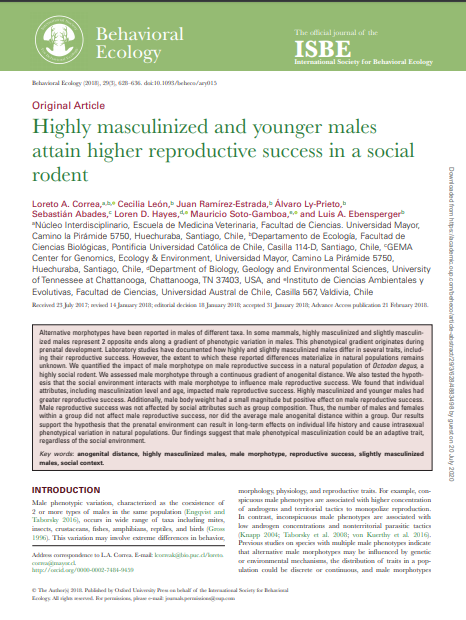Highly masculinized and younger males attain higher reproductive success in a social rodent

Fecha
2018Autor
Correa, Loreto A. [Univ Mayor, Fac Ciencias, Escuela Med Vet, Nucleo Interdisciplinario, Camino Piramide 5750, Santiago, Chile]
Leon, Cecilia
Ramírez-Estrada, Juan
Ly-Prieto, Alvaro
Abades, Sebastián
Hayes, Loren D.
Soto-Gamboa, Mauricio
Ebensperger, Luis A.
Ubicación geográfica
Notas
HERRAMIENTAS
Acceda a títulos restringidos
¿Cómo descargar?Resumen
Alternative morphotypes have been reported in males of different taxa. In some mammals, highly masculinized and slightly masculinized males represent 2 opposite ends along a gradient of phenotypic variation in males. This phenotypical gradient originates during prenatal development. Laboratory studies have documented how highly and slightly masculinized males differ in several traits, including their reproductive success. However, the extent to which these reported differences materialize in natural populations remains unknown. We quantified the impact of male morphotype on male reproductive success in a natural population of Octodon degus, a highly social rodent. We assessed male morphotype through a continuous gradient of anogenital distance. We also tested the hypothesis that the social environment interacts with male morphotype to influence male reproductive success. We found that individual attributes, including masculinization level and age, impacted male reproductive success. Highly masculinized and younger males had greater reproductive success. Additionally, male body weight had a small magnitude but positive effect on male reproductive success. Male reproductive success was not affected by social attributes such as group composition. Thus, the number of males and females within a group did not affect male reproductive success, nor did the average male anogenital distance within a group. Our results support the hypothesis that the prenatal environment can result in long-term effects on individual life history and cause intrasexual phenotypical variation in natural populations, Our findings suggest that male phenotypical masculinization could be an adaptive trait, regardless of the social environment.
URI
https://doi.org/10.1093/beheco/ary015http://repositorio.umayor.cl/xmlui/handle/sibum/6301
https://academic.oup.com/beheco/article/29/3/628/4883498?login=true
Coleccion/es a la/s que pertenece:
Si usted es autor(a) de este documento y NO desea que su publicación tenga acceso público en este repositorio, por favor complete el formulario aquí.